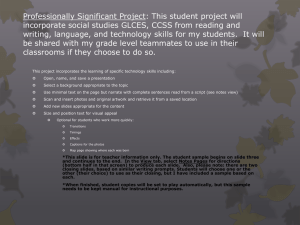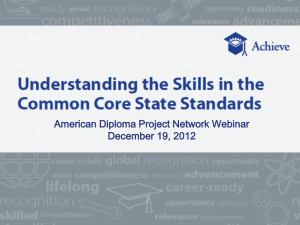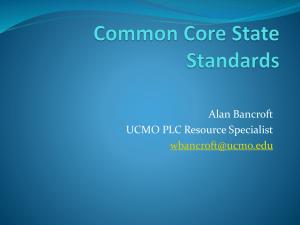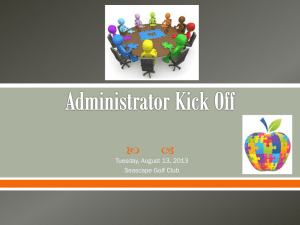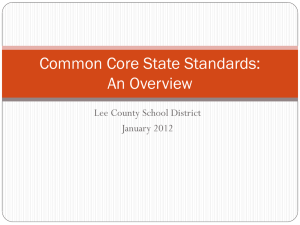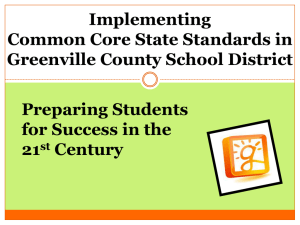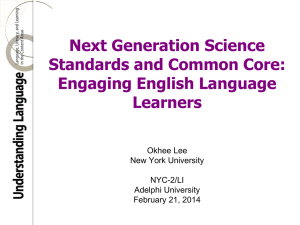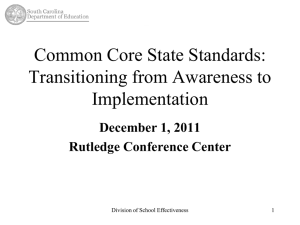Modeling - CESA #2
advertisement
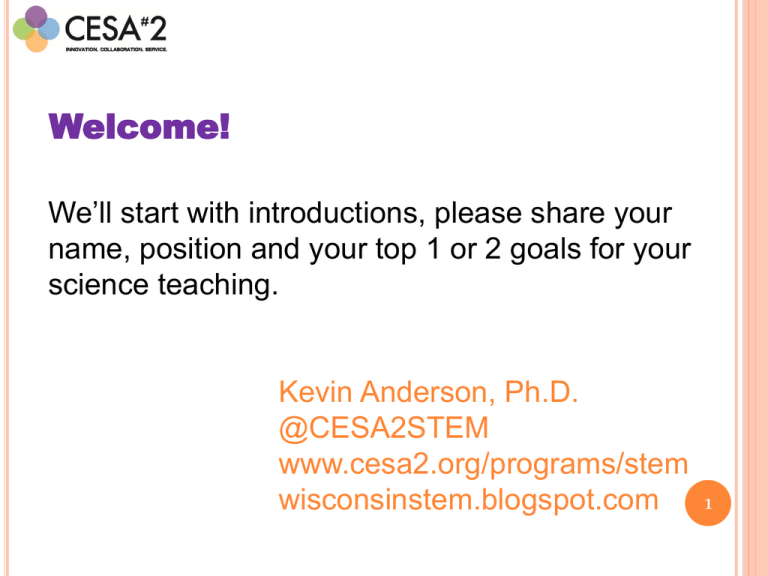
Welcome! We’ll start with introductions, please share your name, position and your top 1 or 2 goals for your science teaching. Kevin Anderson, Ph.D. @CESA2STEM www.cesa2.org/programs/stem wisconsinstem.blogspot.com 1 NGSS Development • The federal government was not involved in this effort and did not fund it. • It was state-led, and states will decide whether or not to adopt the standards. • The work undertaken by the NRC and Achieve was/is being supported by the Carnegie Corporation of New York. • Professional organizations (like ASEE, NSTA), teachers, scientists, engineers, etc. were heavily involved in development. 2 Overview of NGSS structure • Observe an NGSS standards page with a partner • What’s different from past standards? • What questions do you have? 3 Performance Expectations 4 Foundation Boxes – 3 Dimensions 5 Science and Engineering Practices Asking questions and defining problems Developing and using models Planning and carrying out investigations Analyzing and interpreting data Using mathematics and computational thinking Constructing explanations and designing solutions Engaging in argument from evidence Obtaining, evaluating, and communicating information 6 Science and Engineering Practices 7 Disciplinary Core Ideas (DCIs) Life Science Physical Science LS1: From Molecules to Organisms: Structures & Processes LS2: Ecosystems: Interactions, Energy, & Dynamics LS3: Heredity: Inheritance & Variation of Traits LS4: Biological Evolution: Unity & Diversity of Life PS1: Matter & Its Interactions PS2: Motion & Stability: Forces & Interactions PS3: Energy PS4: Waves & Their Applications in Technologies for Information Transfer Earth & Space Science Engineering & Technology ESS1: Earth’s Place in the Universe ESS2: Earth’s Systems ESS3: Earth & Human Activity ETS1: Engineering Design ETS2: Links Among Engineering, Technology & Society 8 Disciplinary Core Ideas (DCIs) 9 Crosscutting Concepts (CCCs) Patterns Cause and effect: Mechanism and explanation Scale, proportion, and quantity Systems and system models Energy and matter: Flows, cycles, and conservation Structure and function Stability and change 10 Crosscutting Concepts 11 Back to any questions about the NGSS structure… 12 Designing lessons example start with a phenomenon What’s going on in the world around us now that could frame your unit? Or, what’s interesting? • • • Life Science: wolf hunt, water pollution, diabetes, bridges for animals, our five senses, winter survival Physical Science: alternative energy, football helmets, communication Earth/Space: severe weather (drought, tornadoes, etc.), mining and the environment, Curiosity mission to Mars, sunrise/sunset, seasons 13 Phenomenon and standards • Let’s say I’m a third grade teacher and want to connect a unit to the stream near our school. • Does it work with my standards? • I would start by looking at the DCI’s 14 What DCI’s could it connect to? • Where would you look? Dig in briefly… • I found: • LS1.A - structure and function of external parts • LS2.A - interdependent relationships in ecosystems • LS2.B - cycles and energy in ecosystems • LS2.C - ecosystem dynamics • ESS3.A - resource availability • ESS3.B - natural hazards • ESS3.C - human impacts on earth systems 15 • ETS1 – developing solutions What PE’s could this unit build toward? • • • • K-LS1-1: Observe what plants and animals need to survive K-ESS3-3: Solutions to reduce human impact 1-LS1-1: Design a solution to a human problem by mimicking animals’ use of external parts 2-LS2-1: An investigation to determine need for sun/water • 3-LS4-2: Variations in organisms help survival • 3-LS4-3: Some organisms survive better • 3-LS4-4: Merit of solution to environmental change • • • 5-LS2-1: Model movement of matter in ecosystem 5-ESS3-1: Ways communities use science to protect the environment K-2 and 3-5 ETS: Designing and testing solutions 16 Start with a phenomenon Connect to background knowledge • What animals live by a river? • What plants live by a river? • What animals or plants live in a river? • Where do these animals (e.g. fish) get their energy? Where do plants get their energy? 17 Model the phenomenon (if appro.) • Picture a river in your head and the plants and animals that live there. Briefly draw out what you see (line drawings). • Upper ES: draw lines between the plants, animals or other parts of your drawing showing where they get energy. • Scaffolding questions: where do you get energy? Where do fish get energy? Where 18 do plants get energy? A story at a river • Vary method depending on grade level • I’m going to read a story to you… • Or, with a reading buddy… • What method would work for your class? • Who, where, why? • Find descriptive words – paints a picture in your mind • What happened that worries these children? 19 Connecting to prior knowledge • What is oil? • How do we use it? 20 Let’s do scientific modeling • Get your drawing of a river back out • Draw a river with an oil spill – what happens to the plants, animals? • Modeling is an • Iterative process • Includes both seen and unseen • Before and after • We’re going to develop the model in groups 21 Individual, group or class modeling? • Could also do modeling as a class • Or, individually on a smaller paper • What would be the advantages or disadvantages of each method? 22 Interim class learning happens… Varying based on grades • • • • • • Day 1: Modeling and reading that we did (more to EiE initial story). Day 2: Visit a local river, stream or pond. What animals and plants do you see there? Make observations. Day 3: Learn more about ecosystems and food webs. See samples of them. Do related EiE reading. Consider field trip ecosystem. Day 4: Compare/contrast various oil samples. Read book, Oil Spill! Narrative writing, imagine you were an animal in a river – what would you be seeing, thinking, feeling if a spill of crude oil happened? Day 5: Kitchen oil spill modeling. Read section in EiE and go through sample methods of cleaning oil as seen in EiE. Day 6: Begin research project (news story). What oil spills have happened? What were the effects? How did people clean them up? 23 Interim class learning happens… • • • • • • Day 7: Continue research work on oil spills. Consider how they affect ecosystems (plants, animals, etc.). Day 8: Background knowledge – engineers. What do they do? How do they solve problems? Have one come in a talk. Day 9: Be an engineer – based on research, plan out new process and develop tool(s) for cleaning an oil spill. Day 10: Link to math work on volumes, measurement, subtraction, and area to support quantitative measurement in oil spill clean up testing. Day 11-14: Continue work on oil spill engineering (and research project). Day 15…: Present methods and research findings. Invite parents. Invite engineer that visited. 24 How could we physically model cleaning an oil spill? • Another example of modeling • How much freedom would you give students to design their own models? • To determine their own clean up methods? 25 Engineering a solution • Brainstorm ideas • Research - What have others done? • What are your constraints? • EiE gives limited flexibility (only particular tools) 26 Modeling cleaning an oil spill • Test three materials (you choose) • Observe and draw oil before and after • Or, measure oil before and after • Alternative – measure size of oil drops before and after (ruler or paper) • Suggest: < 100 mL total, < 20 mL oil • Finding volume (Grade 3 CCSSM) – how much oil did you remove? How much remained? How much water did you remove 27 and how much remained? Scientific Writing/Notebooking • Explanation = Claim + Evidence + Reasoning • A claim that answers the question • Evidence from students' data • Reasoning that involves a "rule" or scientific principle that describes why the evidence supports the claim 28 Scientific Explanations & Notebooks • Example - Claim, Evidence, Reasoning • http://www.youtube.com/ watch?v=WQTsue0lKBk 29 Scientific Explanation Example Q: Is air matter? Air is matter (claim). We found that the weight of the ball increases each time we pumped more air into it (evidence). This shows that air has weight, one of the characteristics of matter (reasoning). • http://www.edutopia.org/blog/science-inquiry-claimevidence-reasoning-eric-brunsell 30 Scientific Explanation Your turn • Fill out the claim, evidence, reasoning form with your group based on your oil spill data • How do you decide if your method worked? That criteria should factor into reasoning portion. 31 Evaluating the physical model • How true to life was our experimental model? • With a neighbor - answer the questions on the “Reviewing your scientific model” worksheet 32 More authentic engineering… • Extensive research first • Budgets and time – each item has cost, project has a budget limit/time limit w/ points for less cost or time • Student designed prototypes • Regulations or client requirements – how much oil is it necessary to remove? • Math infused • Iterate – use group findings to try again (and 33 again), weighing strengths/weaknesses • Present – defend your ideas Return to the ecosystem model • Look back at your original model of the river ecosystem • Using what you have learned – draw the model again. • Would have students do this… why? 34 How to assess student learning? • • • • • • • • • • Report on research Physical model review Final model CER worksheet (rubric on back) Observations of lab and research methods Performance assessment – find a volume Notebooks Given claim and evidence, write reasoning Other ideas? Consider PE’s… 35 Linking to NGSS dimensions • Which NGSS practices did we use? • Which crosscutting concepts relate to this unit? • Note: don’t force it! One or two done well are better than six done at surface level 36 Linking NGSS to CCSS Math and ELA The practices overlap. • • • What are the important connections you see in these subjects? What other connections would you add? What does this suggest for your teaching? 37 Reviewing your lessons • Consider a current science unit/lesson that you do with students • Group modeling - share the lesson essentials and related assessment • What are some ways to better connect it to the NGSS? • With a partner – discuss a lesson briefly: • How could you better include the practices and cross cutting concepts? 38 • Interdisciplinary connections? Revising a unit/lesson, steps… What would you do? 1) Consider the purpose of the lesson. What can you cut out? 2) More writing in science 3) More modeling (with writing) 4) Showing evidence 5) Questioning each other, discourse 6) Relate to a phenomenon 7) Revisit and reflect on lessons 8) Focus on being able to read the NGSS 9) Consider how to best assess students 39 10) Consider connections instead of add-ons Further CCSS Mathematics Links Foundations of Integration 1) Belief in the importance of doing it. 2) Time in the day – overlap math and science and writing/reading time – PBL! 3) Plan out the goals for each, find the overlaps. 4) Build from curriculum examples - start small! 5) Collaborate – don’t try to do it all yourself. 40 Further CCSS Mathematics Links Key Connections - #1 Science Provides the Context • • CCSS 3 MD-2 “e.g., by using drawings (such as a beaker with a measurement scale) to represent the problem” – what? Use a real beaker! CCSS 3MD-3 connecting to NGSS 3-ESS2-1 Represent data in tables and graphical displays to describe typical weather conditions expected during a particular season. • See Appendix L 41 Further CCSS Mathematics Links Key Connections #2 – Math is a tool • Math provides the tools to answer the science question, to solve the engineering problem. • Consider a lesson where students consider what materials would work best for the table tops in a science room. • What math and science connections can you find or create? • NGSS 5-PS1 • CCSS 3.MS, 6.G 42 Further CCSS Mathematics Links Key Connections #3 – Relationships Math • Rates of change, graphs Science • Direct vs. inverse relationships • e.g. – more force = faster and more friction = slower • Ex. growth of plants under different conditions (in class, school garden, prairie) 43 Further CCSS Mathematics Links Key Connections #4 – Modeling • What is mathematical modeling? • What is scientific modeling? • In both you’re making sense of a question or problem. It’s active, not passive. It’s predicting, not reporting. • Examples: • WMC article • Bromine gas 44 Figure 1 Further CCSS Mathematics Links Key Connections #5 – You find one • Look at the science standards at your grade level. • What science concepts require mathematics? • What math concepts that you teach would be more clear (and build better conceptual understanding) with a science connection? • Brief share with a neighbor 45 Further CCSS ELA Links Key Connections #1 – Notebooking • What is a science notebook? • Structure • First 3 pages blank for your table of contents • Number every page (upper right or left corner) of the notebook except your table of contents • Use pencil or colored pencil on both sides of page • Date each page at the start of an investigation 46 Further CCSS ELA Links Key Connections #1 – Notebooking • What is put in a science notebook? Observations and Questions, structured or not 47 Further CCSS ELA Links Key Connections #1 – Notebooking • What is put in a science notebook? Data tables and analyses CER Conclusions 48 Further CCSS ELA Links Key Connections #1 – Notebooking • What is put in a science notebook? Diagrams (ABCD): Accurate Big Colorful Detailed 49 Further CCSS ELA Links Key Connections #1 – Notebooking • What is put in a science notebook? Diagrams: Flaps and Foldables 50 Further CCSS ELA Links Key Connections #1 – Notebooking • What is put in a science notebook? Diagrams: Fill in or not (scaffold) 51 Further CCSS ELA Links Key Connections #1 – Notebooking • What is put in a science notebook? Graphic organizers KWL Concept maps Venn diagrams Flow charts 52 Further CCSS ELA Links Why science notebooks? 1) They are thinking tools. 2) They guide teacher instruction. 3) They enhance literacy skills. 4) They can differentiate learning. 5) They support teacher and student collaboration. 53 Further CCSS ELA Links Key Connections #2 – Disciplinary Literacy “Communication (thinking, speaking, listening, reading & writing) in science allows us to consider our prior knowledge and explore new perspectives while we ask scientific questions, make sense of data, explain and defend our reasoning as we interact with the natural and designed world” – DPI statement • http://dpi.wi.gov/stn_dl-suitcase 54 Further CCSS ELA Links Key Connections #2 – Disciplinary Literacy Close reading: 1. Teacher introduces the text and sets the purpose, and students read. 2. Students annotate the text, i.e., “read with a pencil” or “interrogate the text.” 3. Students talk through their understanding of the text with a partner. 4. Teacher reads passages of text out loud as students follow along. 5. Teacher guides discussion (whole group, small group, or partners) of the passage with text-dependent 55 questions. Further CCSS ELA Links Key Connections #2 – Disciplinary Literacy Close reading Annotating the text 56 Further CCSS ELA Links Key Connections #3 – TALK! • How often do your students talk about science, about math, about their writing with each other? • How often do they “argue with evidence” about an answer or an issue? • How often do they verbally or in writing share their thinking and reasoning? • Do they write research papers about ideas meaningful to them? • http://inquiryproject.terc.edu/shared/pd/Goals_and_M 57 oves.pdf - Ideas for improving talk Work on your unit… Phenomena • • • • • Phenomena driving question • Crosscutting concepts provide the lens with which to frame the driving question Patterns of change can be used to make predictions Driving Question(s): What weather can we predict by looking for patterns? Are there any patterns for extreme weather in the area? How will birds respond to weather patterns (normal or extreme) to survive? Cause and effect relationships are routinely identified Driving Question(s): How does the force of wind change the land? How can humans impact survival of 58 local birds in extreme weather? Essential Questions and CCC’s 1) Is there a pattern in which ponds, streams, and lakes make people sick and which do not? What are the similar of different characteristics of each? 2) Will we get sick (effect) if we go swimming in that pond (cause)? 3) What percentage of people get sick? What are the physical characteristics of the ponds and streams that people are getting sick in (in terms of flow rates and size)? What is the scale of the organisms within the water? 4) What are the important parts of this pond ecosystem and geological system? How could we model this pond? What would be the limitations and benefits of such a model? 5) Where does energy come from in this pond ecosystem and geological system? 6) What are the characteristics of these organisms and people that lead to them making us sick? Consider their relevant body structures and our relevant body structures, along with the functions that they have. 7) How has this pond changed over time, such as from the spring to the59fall, or in the past 40 years? Why do people sometimes get sick while swimming in it, but sometimes they do not? Working on your unit, consider… • • • • • • • Modeling Claim + evidence + reasoning = explanation Practices (appendix) DCI’s CCC’s (appendix) PE’s CCSS ELA and math connections 60 Understanding by Design Template • Understandings - major goals for the year • Essential questions - link to phenomena and CCC’s • Students will know – DCI’s, nitty gritty content • Students will be able to – practices! • Assessment – products, tests, PE’s 61 Reviewing appendices Each group will be assigned an appendix Your task: • Share a key quote (that sums it up) • Generate ideas on how you might use it to guide instruction, course planning, collaboration, etc. 62 Yearly planning template… • How do I map out the full year? 63 What are the next steps? With a partner/team • Think through your next steps in implementation • Prioritize what you need to do • Consider my blog list • What do you plan to do: • In the next week? • In the next 2-3 months? • By the end of the year? • What challenges do you expect? • Earth and Space Science integration! 64 • Share and question Review what we did What are your main takeaways from this workshop? (T&T) What questions do you still have? Email me any time: kevin.anderson@cesa2.org http://www.cesa2.k12.wi.us/programs/stem/ @CESA2STEM wisconsinstem.blogspot.com 66

